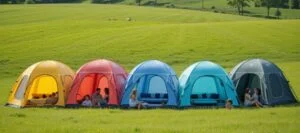Camping in extreme weather conditions is not for the faint-hearted. Whether you’re braving howling winds, heavy snow, or torrential rain, having the right tent can mean the difference between a safe, enjoyable adventure and a miserable, potentially dangerous experience. But what makes a tent suitable for extreme weather? Let’s break down the essential features and considerations to help you choose the best tent for your next expedition.
Four-Season Tents: Built for the Harshest Conditions
If you’re planning to camp in extreme weather, a four-season tent is a must. Unlike three-season tents designed for milder conditions, four-season tents are built to withstand the rigors of winter, high-altitude camping, and unpredictable weather.
Key Features of Four-Season Tents:
- Sturdy Construction: These tents use heavier-duty materials and reinforced pole systems to handle strong winds and heavy snow loads.
- Full-Coverage Rainfly: A full rainfly that extends to the ground offers superior protection from snow and rain.
- Reduced Ventilation: While this might seem like a downside, reduced mesh helps retain warmth and block out wind.
Pro Tip: Even within the four-season category, look for tents specifically rated for the conditions you’ll face, such as snow-focused mountaineering tents or all-around expedition models.
Durability and Materials: Tough Enough for the Elements
The material of your tent determines how well it can stand up to extreme weather conditions. Look for durable fabrics, high-denier ratings, and robust pole systems.
What to Look For:
- Tent Fabric: Ripstop nylon and polyester are common in high-performance tents. Ensure the material has a waterproof coating, such as polyurethane (PU) or silicone.
- Denier Rating: A higher denier rating (e.g., 70D or higher) means the fabric is thicker and more resistant to tears.
- Poles: Aluminum poles are lightweight but exceptionally strong, making them ideal for extreme weather. Avoid fiberglass poles, which are prone to breaking in high winds.
- Seam Sealing: Fully taped or welded seams are essential to prevent leaks during heavy rain or snow.
Why It Matters: In extreme conditions, a tear in the fabric or a broken pole can leave you exposed. Investing in high-quality materials ensures your tent can handle anything nature throws at it.
Wind Resistance: Stay Grounded in the Storm
Strong winds are a hallmark of extreme weather, and your tent must be designed to stay put, even in the fiercest gusts.
Features for Wind Resistance:
- Aerodynamic Shape: Look for low-profile, dome-shaped tents that allow wind to flow over them rather than catching on flat surfaces.
- Guy Lines and Stakes: Strong, reflective guy lines and durable stakes are crucial for anchoring your tent securely. Snow stakes or sand anchors may be necessary for specific terrains.
- Reinforced Poles: Flexible yet strong poles help the tent absorb wind forces without breaking.
Pro Tip: Practice setting up your tent and anchoring it properly before heading out. Knowing how to pitch your tent securely can make a huge difference in extreme conditions.
Waterproofing: Staying Dry in Torrential Rain
Rain and snow can quickly turn a camping trip into a soggy disaster if your tent isn’t waterproof. Extreme weather tents are designed to keep you dry no matter how much precipitation falls.
Waterproofing Essentials:
- Hydrostatic Head Rating: This measures how waterproof the fabric is. For extreme conditions, look for ratings of 3,000mm or higher for the rainfly and tent floor.
- Bathtub Floor: A raised, waterproof floor prevents water from seeping in from below.
- Full Rainfly Coverage: Ensure the rainfly extends close to the ground for maximum protection.
- Ventilation to Prevent Condensation: Waterproofing is critical, but proper ventilation reduces condensation inside the tent, keeping you and your gear dry.
Quick Tip: Regularly reapply waterproof coatings to maintain your tent’s performance over time.
Snow and Cold Weather: Insulation and Heat Retention
Camping in snowy or subzero conditions requires a tent that can handle the weight of snow and retain heat effectively.
Features for Snowy Conditions:
- Snow-Loading Capacity: Look for tents with steep, angled walls that allow snow to slide off rather than accumulating on top.
- Insulation: Double-wall tents with reduced mesh are better for retaining heat.
- Vestibules: Extra storage space for wet or snowy gear prevents moisture from entering the sleeping area.
- Snow Flaps: Some tents feature flaps that can be buried in snow to provide extra stability and insulation.
Why It Matters: A tent that collapses under snow or fails to keep you warm can ruin your trip—or worse, compromise your safety.
Ease of Setup in Harsh Conditions
When the wind is howling, or the temperature is dropping fast, you need a tent that’s quick and easy to set up. Complicated designs can leave you exposed for longer than necessary.
Setup Considerations:
- Color-Coded Poles and Clips: These make assembly intuitive, even in low-light or bad weather.
- Freestanding Design: A freestanding tent can be set up on uneven terrain without requiring stakes.
- Integrated Components: Some extreme weather tents come with pre-attached rainflies or footprints to reduce setup time.
Pro Tip: Practice pitching your tent at home to familiarize yourself with the process, especially if conditions require quick action.
Extra Features for Comfort and Safety
Beyond the essentials, some additional features can improve your camping experience in extreme weather.
- Ventilation Systems: Adjustable vents and breathable fabrics prevent condensation while maintaining warmth.
- Interior Pockets: Keep gear organized and off the floor.
- Reflective Elements: Reflective guy lines and stakes improve visibility in low-light conditions.
- Weight Considerations: While extreme weather tents tend to be heavier, some ultralight models are designed specifically for backpackers.
Top Recommendations for Extreme Weather Tents
Here are some of the best tents for extreme weather camping:
The North Face VE 25
-
- A classic expedition tent designed for harsh alpine conditions. It features robust poles, excellent ventilation, and reliable waterproofing.
Hilleberg Nammatj 2
-
- Known for its durability and versatility, this tent performs well in extreme cold and wind.
MSR Access 2
-
- Lightweight and compact, ideal for backcountry adventures in snowy conditions.
Black Diamond Eldorado
-
- A single-wall tent with exceptional wind and snow resistance, perfect for mountaineering.
Mountain Hardwear Trango 2
-
- A bombproof design with a spacious interior, built for harsh weather and extended stays.
Explore More on Extreme Weather Camping
For tips on maintaining your gear in top shape, check out our guide on how to repair a torn tent. A sturdy tent is your first line of defense against extreme conditions, and knowing how to fix small issues can save your trip.
Planning to camp in subzero temperatures? Learn about the best 4-season tents for year-round adventures, specifically designed to handle snow, wind, and freezing temperatures with ease.
Conclusion: Choosing the Right Tent for Extreme Weather
Finding the best tent for extreme weather requires balancing durability, weather resistance, weight, and ease of setup. While four-season tents are an obvious choice, consider the specific conditions you’ll face—whether it’s high winds, heavy snow, or torrential rain.
Reviewed and updated on 01/24/2025




